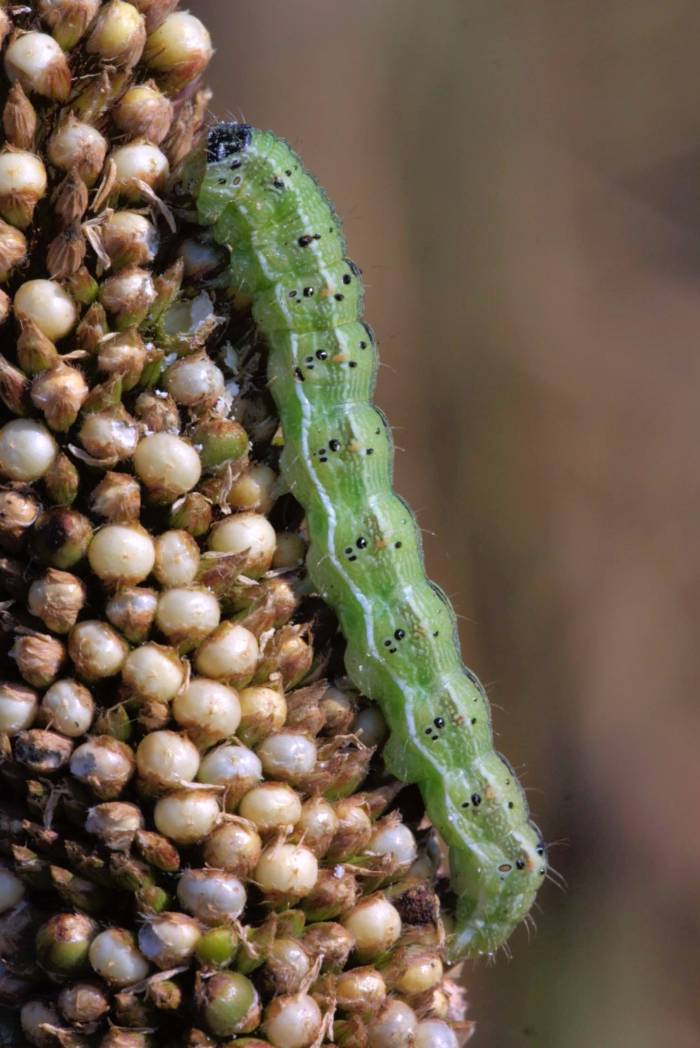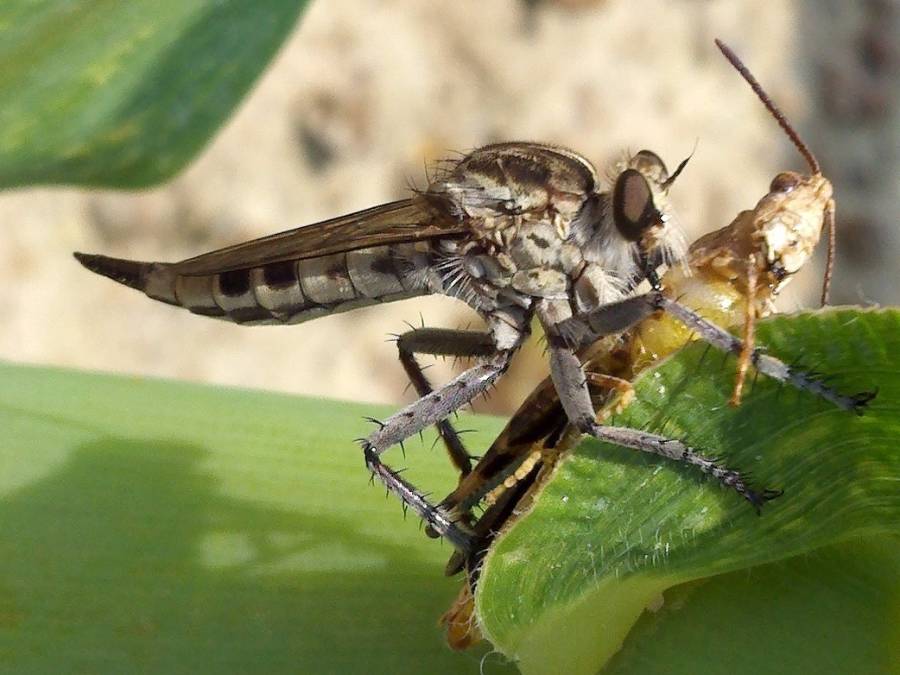OHNL - October 2017
Insect Life and Climate Change: Pollinators and Pests
Authors
Erin Strathe
DVM Student, Class of 2019
College of Veterinary Medicine
Kansas State University
Rebecca Tomasek
DVM/MPH Student, Class of 2021
College of Veterinary Medicine
Kansas State University
Joaquin Baruch
PhD Student
Diagnostic Medicine and Pathobiology
College of Veterinary Medicine
Kansas State University
Faculty Contributor
Dr. John Ruberson
College of Agriculture
Kansas State University
The variations in temperatures and weather patterns associated with climate change could impact insect species in a variety of ways. For some species, these changes could have a negative impact, but for others it could be beneficial depending on the insects' role in plant, animal, and human health.
Dr. John R. Ruberson, entomologist at KSU, highlights the contradictory role insects play in the ecosystem:. "Insects and other arthropods play critical and highly conflicting roles in human life. On one hand, they compete with us directly and indirectly for our food and they carry devastating pathogens that sicken and kill millions of people and livestock and countless crop plants each year, often in the poorest parts of the world. Many species also act as natural enemies against those same pests that compete for our food and sicken us, our crops and our animals. They also pollinate immense amounts of fruit, nuts, and vegetables that are so important for our diets. They decompose plants and animals to recycle their nutrients, and they reshape soil structure to build the health of our soils. And they are often critical food resources for vertebrates."
|
Corn earworm on sorghum: |
Adaptation to Changes - Dangers to Plant Life
Many plant pests will likely adapt well to the warming temperatures. For example, the pupae of the adult Cotton Bollworm, a pest of grain crops, could emerge up to 7 days earlier from winter diapause when temperatures increase [1]. The same phenomenon was demonstrated in the Bean Leaf Beetle, a pest of soybean plants in the U.S. When the beetles were exposed to supplemental winter warming, they emerged two to three weeks earlier than the control population [2]. This early emergence ultimately leads to a second reproductive generation, thus potentially increasing the amount of feeding damage on crops [1].
Another threat to crops is the expansion of pest species into new zones. For example, Anopothrips obscurus, a serious pest of cereal crops, has an optimal developmental and reproductive temperature range that could allow it to adapt to warmer temperatures and widen its distribution in northwestern China in response to warmer temperature [3].
Bees may also be directly impacted by changing temperatures. While the increased temperatures could aid some bees in allowing them to expand into new territories, others will be negatively impacted. In one study of honey bees under conditions of heat stress, the bees exhibited a change in activity. Bees that normally displayed foraging activity began to act more like "nurse" bees by remaining in the hive. It is hypothesized that these bees may be tasked with fanning the hive in order to cool it. Indeed, the brood requires a narrow range of temperatures for thermoregulation and thus may require more bees to aid in fanning the hive when temperatures rise [4]. Ultimately, as bees change from foraging to nursing, they will no longer be feeding on plants and picking up pollen.
The increased activity of natural enemies of bees at increased temperatures has also been shown to be detrimental to bees. A study on a species of subalpine pollen-specialist bees found that, under warmer temperatures, their overall reproductive output decreased. This phenomenon occurred despite positive effects of warmer temperatures, such as increased activity levels and rate of nest construction. The hypothesized cause of such an unexpected outcome is linked to the increased activity of a brood parasite wasp. Brood parasites kill bee eggs, leading to reduced reproduction [5]. This potential reduction in population could therefore outweigh any benefits observed in response to warming temperatures.
Potential Benefits
Some pest species have been shown to be increasingly susceptible to their natural enemies as a result of a changing climate. For example, in a study on cereal pest aphids, warming temperatures changed the composition of the population by reducing the proportion of winged aphids, making them more susceptible to their natural predator, the lady beetle [6]. Additionally, commercial biological control agent nematodes were more effective in controlling damage caused by terrestrial slugs in lettuce in the presence of warmer winter temperatures [7]. These studies provide evidence that the use of natural predators for biological control of plant pests could be more effective in warming climate conditions.
Threats to Crop Production
As insect life changes due to climate variance, crop production is impacted. Climate change has modified dispersal of viruses that are spread by insects, and insect migration potential. The widespread transport by migrating insects has been associated with viral epidemics affecting maize, stemming from the southern Great Plains and spreading as far north as Minnesota [8].
Furthermore, the extended warmer season is a concern for crop production due to the effects on the relationships between insects and their host plants. The seasonal changes have lengthened the window for certain insect species' ideal environmental conditions. Direct effects of temperature change will vary among species, according to their existing environments and ability to adapt. Many insect species feeding on specific plants will face pressure to adapt as the plants on which they feed undergo changes in their growth cycle [9]. Normally, the natural timing of the insect lifecycle synchronizes with the lifecycle of the plants on which they feed. However, climate change has caused mostly negative consequences from the increasing asynchrony in ecological systems, due to variation in the phenological responses of insects and their host plants [10].
Solenopsis mealybug on cotton in India: |
Prediction of Changes
Risk assessment, preparedness, and mitigation have become more critical in reducing damage to crops as climates change. Spatial predictions can determine the areas expected to be most affected by pests or viruses, which can be used to reduce the amount of insecticides needed. In Japan, models demonstrated the areas of high priority, where resources were to be focused. This allows appropriate insecticide applications to be applied in these areas, while restricting insecticide use in low priority areas [11]. Use of insecticides has had negative effects on non-target species, including fish, birds, and humans. Additionally, resistance to these chemicals is increasing in targeted insect populations. Limiting use of these chemical toxicants and finding alternative pest control methods is critical in reducing the crop damage [12]. While risk assessments will become integral in pest control, integrating knowledge of phenological processes of insects and plants will provide more useful models [13].
The Need for One Health
Climate change is challenging our understanding of the role of arthropods in their ecosystems. Ruberson cautions, "Increasing climatic variability, especially warmer and longer summers, will certainly change these interactions that we already poorly understand."
"We have gotten the upper hand on some of the most serious arthropod problems over the past few hundred years, but we still have a long way to go, and now the playing field appears to be changing to a whole new game with unknown rules. It's not a pleasant place to be..." says Ruberson.
Without knowing what changes will occur or the impact these changes may have, we are left with many unanswered questions, and a large unmapped area of risk. It is certain, however, that the prediction and solutions to these issues will require an interdisciplinary approach. Experts across multiple disciplines will need to come together to insure that the changes in the ecosystem are not diminishing the quality of life of animals and humans. This will only be possible using One Health principles.
|
Asilid with grasshooper: |
Resources
- Ouyanga, Fang, et. al. "Early eclosion of overwintering cotton bollworm moths from warming temperatures accentuates yield loss in wheat." Agriculture, Ecosystems and Environment 217 (2016), 89–98.
- Berzitis, Emily A., et. al. "Winter warming effects on overwinter survival, energy use, and spring emergence of Cerotoma trifurcata (Coleoptera: Chrysomelidae)" Agricultural and Forest Entomology 19 (2017), 163–170.
- Jiang, Hong-xue, et. al. "Effects of temperature on the development, reproduction and population growth of Anaphothrips obscurus (Thysanoptera: Thripidae)" Journal of Asia-Pacific Entomology 19 (2016), 1175–1181.
- Bordier, Célia, et. al. "Stress response in honeybees is associated with changes in task-related physiology and energetic metabolism." Journal of Insect Physiology 98 (2017), 47–54.
- Forrest, Jessica R. K. and Sarah P. M. Chisholm "Direct benefits and indirect costs of warm temperatures for high-elevation populations of a solitary bee." Ecology, 98(2), 2017, 359–369.
- Wang, Ying-Jie, et. al. "Warming impact on herbivore population composition affects top down control by predators." Scientific Reports 7: 941 (2017).
- El-Danasoury, Heba and Javier Iglesias-Piñeiro "Performance of the slug parasitic nematode Phasmarhabditis hermaphrodita under predicted conditions of winter warming." Journal of Pesticide Science 42(2) (2017), 62–66.
- Canto, Tomas et. al. "Climate change effects on physiology and population processes of hosts and vectors that influence the spread of hemipteran-born plant viruses." Global Change Biology 15(8) (2008), 1884-1894.
- Bale, Jeffrey S., et. al. "Herbivory in global climate change research: direct effects of rising temperatures on insect herbivores." Global Change Biology 8 (2002), 1-16.
- Parmesan, Camille. "Ecological and Evolutionary Responses to Recent Climate Change." Climate-Change Impacts 37 (2006), 637-669.
- Tabuchi, Ken, et. al. "Predicting potential rice damage by insect pests using land use data: A 3-year study for area-wide pest management." Agriculture, Ecosystems & Environment 249 (2017), 4-11.
- Singh, Balwinder and Amritpal Kaur. "Control of insect pests in crop plants and stored food grains using plant saponins: A review." LWT- Food Science and Technology 87 (2018), 93-101.
- Thomson, Linda J. et. al. "Predicting the effects of climate change on natural enemies of agricultural pests." Biological Control 52 (2010), 296-306.
K-State Olathe
22201 W. Innovation Dr.
Olathe, KS 66061-1304
913-541-1220
913-541-1488 fax
olatheinfo@k-state.edu

